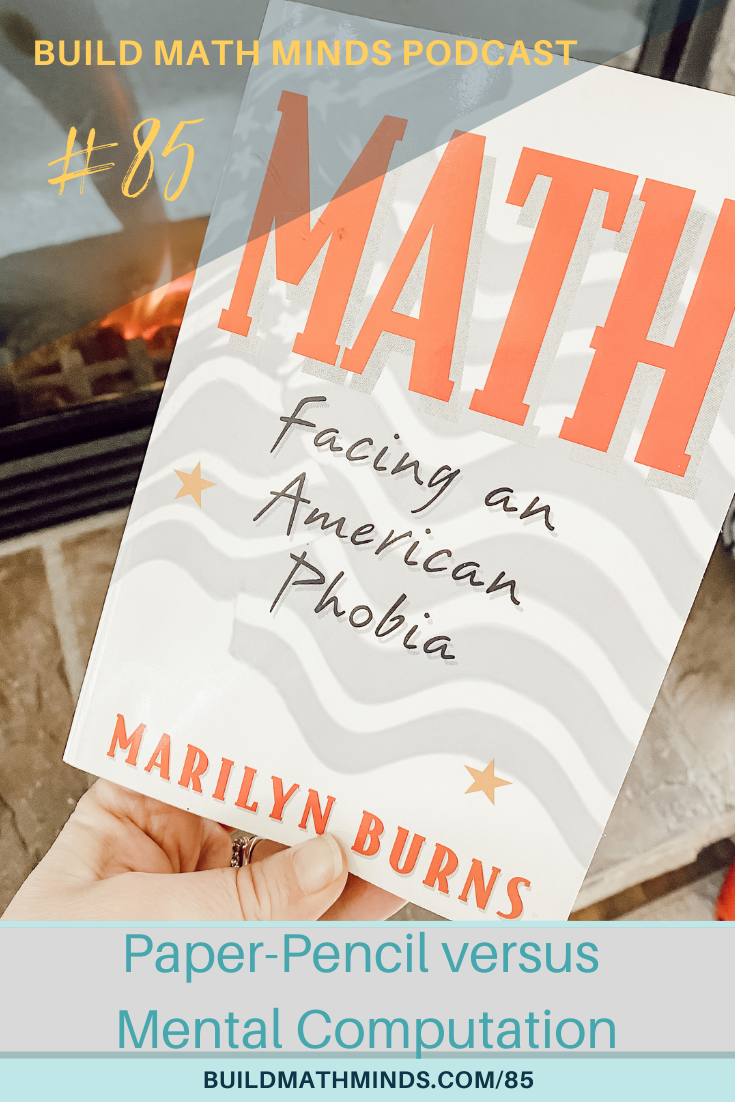Resources mentioned in this episode:
Math: Facing an American Phobia by Marilyn Burns
Become a member of the Build Math Minds PD site
Welcome fellow Recovering Traditionalists to Episode 85. Today we are looking at Paper-Pencil versus Mental Computation.
It seems like there is a debate about everything in how we teach math. One of those debates is whether or not kids should do paper-pencil math or mental math. If you’ve been around awhile you can probably guess where I land on this debate….right in the middle, kids need both.
In the book Math: Facing an American Phobia by Marilyn Burns she pretty much sums up my thoughts on pages 10-11:
“Learning to compute with paper and pencil does not necessarily prepare children to compute mentally. Although paper-and-pencil procedures give children efficient ways to do computations, a danger is that children may learn to do them by rote rather than rely on reasoning. Yet reasoning numerically is essential in order to compute mentally. No one method for doing arithmetic in our head is useful in all situations. The method we use depends on the numbers we’re dealing with, the context in which we encounter them, and the extent to which we need to be accurate.
By the time children leave elementary school, they should be able to do mental calculations with all numbers up to at least 100. Developing this proficiency requires practice. Yet more than 75 percent of the arithmetic instruction we received was spent on practice with paper and pencil. Little attention was given to mental computation. And while children should be able to figure with paper and pencil, what we’ve long needed is to provide a balance between learning to use paper and pencil and learning to calculate mentally.”
That was published in 1998. Over 20 years later there is a lot of emphasis on mental computation happening, which is a great thing. However, I’m also hearing complaints that now kids can’t do paper-pencil computation. I don’t know what the right mix is of mental and paper-pencil work, but I want to encourage you to reflect upon how much of each is happening in your classroom.
Throughout the entire book, Marilyn helps the reader see how math is a part of our daily lives and how we should be incorporating those situations we encounter in life into the classroom so our students can see how useful and non-scary math is.
So as you reflect upon what kind of mix of paper-pencil and mental computations you want your students to experience, I want you to think about what we tend to use in our daily lives. Do we do more paper-pencil or mental? Again not to say we need to do away with one or the other, but we want kids to experience math in school the same way they experience it in their life, which is a mix of both, and that helps them not experience the math phobia. There are times I do paper-pencil computations, but the majority of my mathematical experiences are mental math and often don’t require an exact answer…but more on that in a future podcast episode.
There were so many pages in this book that I dog-eared and highlighted that I will be sharing more from the book in the future, but as always I will encourage you to get the book for yourself so you can dig into it and find the parts that resonate with you and where you are right now in your teaching practice.
Subscribe and Review in iTunes
Hey, are you subscribed to the Build Math Minds Podcast, yet? If you’re not, make sure to do that today because I don’t want you to miss any episodes! Click here to subscribe to the podcast in iTunes.
While you’re there, don’t forget to leave a review on iTunes too. I would love to know your thoughts and how we can make sure that we give you content that you will really enjoy.
To leave a review, head over to iTunes and click on “Ratings and Reviews” and “Write a Review.” I can’t wait to hear your thoughts about the podcast.




